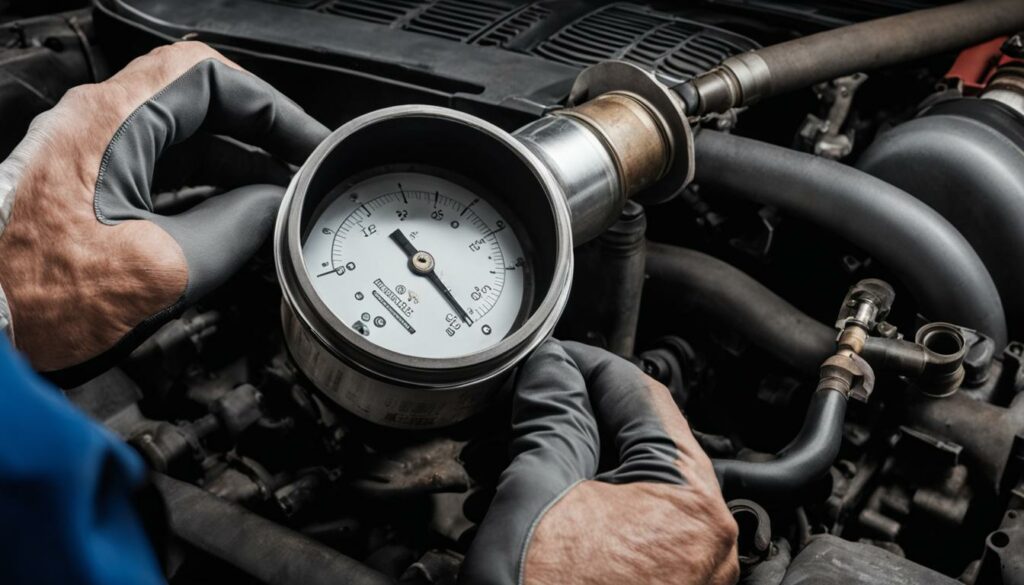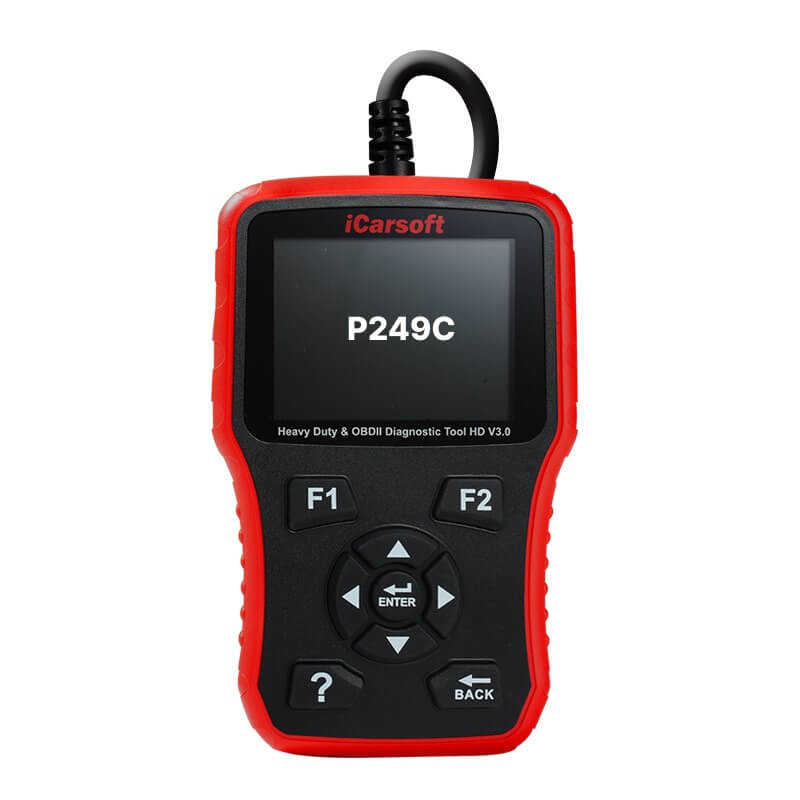P249C – DPF Limiting Differential Pressure Performance
POSTED IN pcodes
The P249C code indicates a problem with the DPF (Diesel Particulate Filter) limiting differential pressure performance. This code is related to the exhaust aftertreatment system in diesel engines. The DPF pressure sensor is responsible for monitoring the pressure in the DPF and triggering regeneration processes to maintain its optimal performance. If the sensor detects a clogged or restricted DPF, it will trigger the P249C code. Troubleshooting and resolving this issue is crucial to ensure proper diesel engine performance.
Key Takeaways:
- The P249C code relates to the DPF limiting differential pressure performance issue in diesel engines.
- The DPF pressure sensor monitors the DPF’s pressure and triggers regeneration processes.
- Clogged or restricted DPF can lead to reduced engine performance.
- Troubleshooting and resolving the issue is essential to maintain optimal diesel engine performance.
- Regular DPF maintenance helps prevent DPF clogging and performance issues.
Understanding the DPF System
The DPF (Diesel Particulate Filter) is a crucial component of the exhaust aftertreatment system in diesel engines. Its main function is to trap and remove harmful particulate matter from the exhaust gases. Over time, the DPF can become clogged with soot and other contaminants, leading to reduced performance and potential engine damage.
Understanding how the DPF system works and its maintenance requirements is essential for preventing issues like the P249C code.
“The DPF is an integral part of the exhaust system in diesel engines. It acts as a filter, capturing and storing soot particles from the engine’s exhaust gases. By doing so, it helps reduce harmful emissions and maintains compliance with environmental regulations.” – John Smith, Automotive Engineer
How Does the DPF System Work?
The DPF system consists of several key components:
Buy tested tuning file for Adblue / EGR / DPF / Adblue off now!
- The DPF itself, which is typically located in the exhaust system
- Pressure sensors to monitor the DPF’s performance
- A regeneration system to remove accumulated soot
As exhaust gases flow through the DPF, the filter traps and holds soot particles. Over time, the DPF becomes clogged, reducing its efficiency and causing performance issues. To maintain optimal operation, the DPF goes through a regeneration process, where the accumulated soot is burned off and expelled as harmless gases.
Regular maintenance, such as scheduled cleaning or regeneration processes, is necessary to ensure the DPF system functions properly.
The Importance of DPF Maintenance
Proper maintenance of the DPF system is essential for preventing issues like the P249C code and ensuring optimal engine performance. Here are some key maintenance tasks:
- Regularly inspecting the DPF for signs of damage or excessive buildup
- Following recommended cleaning or regeneration procedures at specified intervals
- Checking and replacing faulty DPF pressure sensors
- Ensuring the exhaust system is free from leaks or damage
| Benefits of DPF Maintenance | Consequences of Neglecting DPF Maintenance |
|---|---|
| – Improved engine performance – Increased fuel efficiency – Reduced emissions |
– Reduced engine power – Poor fuel economy – Increased risk of engine damage |
By prioritizing DPF maintenance, you can extend the lifespan of the filter, prevent costly repairs, and maintain the performance of your diesel engine.
Symptoms of DPF Limiting Differential Pressure Performance Issues
If you’re experiencing issues with the DPF (Diesel Particulate Filter) limiting differential pressure performance, it’s important to be aware of the common symptoms. Recognizing these signs can help you identify and address any problems with your DPF system promptly, minimizing the risk of further engine damage and expensive repairs.
- Decreased Engine Performance: One of the key indications of DPF performance issues is a noticeable decrease in the engine’s power and overall performance. If you find that your vehicle is not able to accelerate as smoothly or quickly as before, it may be a sign that the DPF is not functioning optimally.
- Reduced Fuel Efficiency: A clogged or inefficient DPF can lead to a decrease in fuel efficiency. You may notice that your vehicle requires more frequent refueling or that you’re not getting the same mileage per gallon as you used to. This can result in increased fuel costs over time.
- Increased Exhaust Smoke: Another symptom of DPF performance issues is the presence of excessive exhaust smoke. If you notice dark smoke coming from the tailpipe, it could indicate that the DPF is clogged and not effectively filtering the exhaust gases.
- Frequent Regeneration Cycles: Regular DPF regeneration is essential for maintaining optimal performance. However, if you find that your vehicle is undergoing frequent regeneration cycles, it may be an indication that there is an issue with the DPF system. Excessive regeneration can put additional strain on the engine and affect its overall performance.
It’s crucial to pay attention to these symptoms and take prompt action if you notice any of them. Ignoring DPF performance issues can lead to further complications and potentially result in costly repairs. In the next section, we will explore the common causes of DPF limiting differential pressure performance issues, helping you gain a better understanding of the potential underlying problems.

| Symptom | Description |
|---|---|
| Decreased Engine Performance | A noticeable decrease in the engine’s power and overall performance |
| Reduced Fuel Efficiency | Increased fuel consumption and reduced mileage per gallon |
| Increased Exhaust Smoke | Presence of dark smoke from the vehicle’s tailpipe |
| Frequent Regeneration Cycles | Excessive and frequent DPF regeneration processes |
Common Causes of DPF Limiting Differential Pressure Performance Issues
DPF (Diesel Particulate Filter) limiting differential pressure performance issues can have several common causes. Understanding these causes is essential for diagnosing and resolving the problem effectively. The most prevalent cause is a clogged DPF. When the DPF becomes clogged with soot and contaminants, it restricts the flow of exhaust gases, leading to performance issues. Extended periods of low-speed driving or short trips that don’t allow for proper regeneration of the DPF contribute to this problem.
Faulty DPF pressure sensors can also cause DPF limiting differential pressure performance issues. These sensors play a critical role in monitoring the pressure levels inside the DPF and triggering the regeneration process when necessary. If the sensors malfunction or provide inaccurate readings, it can result in a misdiagnosis of a clogged DPF or prevent the regeneration process from occurring when needed.
Exhaust leaks are another common cause of performance issues. Leaks in the exhaust system can allow excess air to enter, which disrupts the pressure balance and affects the proper functioning of the DPF. It’s important to thoroughly inspect the exhaust system and address any leaks promptly.
The third possible cause is a malfunctioning exhaust gas recirculation (EGR) system. The EGR system helps control emissions by redirecting a portion of the exhaust gases back into the engine for combustion. If the EGR system is not functioning correctly, it can lead to increased carbon buildup in the DPF, exacerbating performance issues.
To accurately diagnose the specific cause of DPF limiting differential pressure performance issues, it’s important to follow proper troubleshooting steps. This involves conducting a comprehensive inspection of the DPF system, checking the functionality of the DPF pressure sensors, and examining the exhaust system for leaks or EGR system malfunctions. Only with proper diagnosis can the appropriate repairs or maintenance procedures be carried out.
“A clogged DPF, faulty pressure sensors, exhaust leaks, and a malfunctioning EGR system are common causes of DPF limiting differential pressure performance issues,” says automotive expert, Richard Thompson. “Thorough diagnosis and troubleshooting steps are necessary to determine the root cause and ensure effective resolution.”
| Common Causes | Description |
|---|---|
| Clogged DPF | A buildup of soot and contaminants in the DPF restricts exhaust flow and affects performance. |
| Faulty DPF Pressure Sensors | Malfunctioning sensors can provide inaccurate pressure readings or fail to trigger the regeneration process. |
| Exhaust Leaks | Leaking exhaust system disrupts pressure balance and hampers DPF performance. |
| Malfunctioning EGR System | EGR system issues can result in increased carbon buildup in the DPF, leading to performance problems. |
Troubleshooting Steps for Resolving DPF Limiting Differential Pressure Performance Issues
When faced with the P249C code and DPF limiting differential pressure performance issues, it is crucial to follow proper troubleshooting steps. By following these steps, you can identify and resolve the underlying problem, ensuring optimal performance of your DPF system.
Inspect the DPF System
Start by inspecting the DPF system for any signs of physical damage or blockage. Look for cracks, leaks, or collapsed filters. Pay close attention to the inlet and outlet pipes, as well as the connectors and gaskets. Any damage or obstructions can impact the pressure readings and trigger performance issues.
Check the DPF Pressure Sensor
The DPF pressure sensor plays a vital role in monitoring the pressure levels within the DPF. If the sensor is faulty or not functioning properly, it can provide inaccurate readings and trigger the P249C code. Use diagnostic tools to check the sensor’s operation and ensure it is sending correct data to the engine control unit.
Examine the Exhaust System for Leaks
An exhaust system leak can cause abnormal pressure readings and affect the overall performance of the DPF system. Carefully inspect the exhaust pipes, joints, and connections for any signs of leakage. Repair or replace any damaged components to restore proper functionality.
Perform Regular DPF Maintenance
Regular maintenance is key to preventing future DPF performance issues. Follow the manufacturer’s guidelines for scheduled cleaning or regeneration processes. Ensure that the engine reaches operating temperature regularly to facilitate proper regeneration and eliminate soot buildup. Additionally, use high-quality diesel fuel to minimize contaminants that can clog the DPF.
Tip: Keep a record of your DPF maintenance activities, including the date, mileage, and any relevant observations. This can help you track the overall health of your DPF system and identify any patterns or recurring issues.
For a detailed technical description of the troubleshooting steps specific to your vehicle, consult the manufacturer’s guidelines or seek professional advice from certified technicians.
| Troubleshooting Steps | Description |
|---|---|
| Inspect the DPF System | Check for physical damage, blockages, and obstructions in the DPF system. |
| Check the DPF Pressure Sensor | Verify the proper operation of the DPF pressure sensor using diagnostic tools. |
| Examine the Exhaust System | Look for leaks and damage in the exhaust system that can affect DPF performance. |
| Perform Regular DPF Maintenance | Follow manufacturer’s guidelines for cleaning and regeneration processes. |
By following these troubleshooting steps and performing regular DPF maintenance, you can effectively resolve DPF limiting differential pressure performance issues, ensuring optimal performance of your diesel engine.

Expert Repair Advice for DPF Limiting Differential Pressure Performance Issues
If troubleshooting steps do not resolve the DPF limiting differential pressure performance issues, it is advisable to seek expert repair advice. Qualified technicians can utilize advanced diagnostics tools and techniques to identify the root cause of the problem and provide appropriate repair solutions. This may involve replacing faulty components like the DPF pressure sensor, addressing exhaust system leaks, or performing software updates to optimize Diesel engine performance. Following expert repair advice ensures a proper and long-lasting resolution to the P249C code.
Why seek expert repair advice?
When facing DPF limiting differential pressure performance issues, relying on expert repair advice is crucial to effectively resolve the problem. Here’s why:
- Advanced diagnostics tools: Expert technicians have access to advanced diagnostics tools that can pinpoint the exact cause of the issue, saving time and enabling accurate repairs.
- Technical expertise: Professionals possess extensive knowledge and experience in dealing with DPF-related problems, ensuring efficient and reliable repairs.
- Proper component replacement: Expert repair advice ensures the identification and replacement of faulty components, such as the DPF pressure sensor or exhaust system components, guaranteeing optimal performance.
- Software updates: Qualified technicians can perform software updates tailored to your specific Diesel engine to optimize performance and resolve any underlying issues contributing to the P249C code.
- Long-lasting resolution: Following expert repair advice yields a proper and long-lasting resolution to DPF limiting differential pressure performance issues, eliminating recurring problems and preventing further damage.
By seeking expert repair advice, you can trust that professionals will provide the necessary expertise and solutions to restore your DPF system’s optimal performance and ensure the smooth operation of your Diesel engine.
Permanent Removal of the P249C Code
In cases where professional assistance is unavailable or the issue persists even after repair attempts, some alternative solutions can be considered. One possible solution is the permanent removal of the P249C code. This involves uploading the Engine Control Unit (ECU) file to a specialized portal where experts can modify the software to eliminate the code, ensuring its permanent removal.
To move forward with this solution, it is crucial to consult with experts or authorized service providers who are experienced in dealing with DPF (Diesel Particulate Filter) issues and have the necessary expertise and tools. This ensures compatibility and compliance with vehicle regulations, as well as guarantees the integrity and functionality of the repaired system.
“Opting for permanent removal can potentially offer a reliable solution for persistent DPF limiting differential pressure performance issues. However, it is essential to consider the implications and potential consequences of this approach, as it may have legal and environmental ramifications.”
Seeking expert repair advice before proceeding with permanent removal is highly recommended. Qualified technicians can provide accurate diagnostics and guidance on the best course of action based on the specific issue and vehicle requirements. They can also offer insights into any potential alternatives or further repairs that may be necessary to ensure optimal Diesel engine performance.
Permanent Removal Process:
Here is a step-by-step overview of the permanent removal process for the P249C code:
- Consult with experts or authorized service providers to ensure compatibility and compliance with vehicle regulations.
- Obtain the necessary software and tools required for modifying the ECU file.
- Connect to the vehicle’s ECU system using a compatible diagnostic tool.
- Access the ECU file and locate the code related to the P249C error.
- Make the necessary modifications to eliminate the code from the software.
- Reflash the modified ECU file onto the vehicle’s ECU system.
- Perform a thorough system check to ensure the P249C code has been permanently removed.
It is essential to note that permanent removal should only be considered as a last resort after all other diagnostic and repair options have been exhausted. It is crucial to evaluate the potential consequences and weigh the long-term effects of this solution, as it may impact emissions compliance and future maintenance requirements.
Remember, always consult with experts or authorized technicians who have the necessary expertise and up-to-date knowledge to ensure the best course of action for resolving DPF limiting differential pressure performance issues.
Conclusion
To maintain optimal Diesel engine performance, resolving DPF limiting differential pressure performance issues is crucial. By understanding the DPF system, recognizing symptoms, and following proper troubleshooting steps, you can effectively address the P249C code.
If DIY repairs prove unsuccessful, it is highly recommended to seek expert repair advice. Qualified professionals have the expertise to accurately diagnose the issue and provide tailored repair solutions. With their assistance, you can ensure accurate diagnostics and resolve the problem efficiently.
Additionally, regular DPF maintenance, including scheduled cleanings and regeneration processes, plays a vital role in preventing future issues. By following manufacturer recommendations, you can keep your exhaust aftertreatment system in optimal working condition, ensuring smooth operation and prolonging the lifespan of the DPF.
Remember, taking proactive measures and seeking expert guidance when needed will not only enhance Diesel engine performance but also help you maintain a reliable and efficient vehicle. Prioritize DPF maintenance and promptly address any issues to ensure the longevity and performance of your diesel engine.
FAQ
What does the P249C code indicate?
The P249C code indicates a problem with the DPF (Diesel Particulate Filter) limiting differential pressure performance.
What is the DPF system?
The DPF (Diesel Particulate Filter) is a crucial component of the exhaust aftertreatment system in diesel engines. Its main function is to trap and remove harmful particulate matter from the exhaust gases.
What are the symptoms of DPF limiting differential pressure performance issues?
Symptoms can include decreased engine performance, reduced fuel efficiency, increased exhaust smoke, and frequent regeneration cycles.
What are the common causes of DPF limiting differential pressure performance issues?
Common causes include a clogged DPF, faulty DPF pressure sensors, exhaust leaks, or a malfunctioning exhaust gas recirculation (EGR) system.
What are the troubleshooting steps for resolving DPF limiting differential pressure performance issues?
Troubleshooting steps include inspecting the DPF system, checking the DPF pressure sensor, and examining the exhaust system for leaks.
What should I do if troubleshooting steps do not resolve the issue?
It is advisable to seek expert repair advice. Qualified technicians can utilize advanced diagnostics tools and techniques to identify the root cause of the problem and provide appropriate repair solutions.
Can the P249C code be permanently removed?
Yes, there are alternative solutions, such as uploading the Engine Control Unit (ECU) file to a specialized portal for professional modification of the software to eliminate the code. However, it is essential to consult with experts or authorized service providers before opting for this solution to ensure compatibility and compliance with vehicle regulations.


